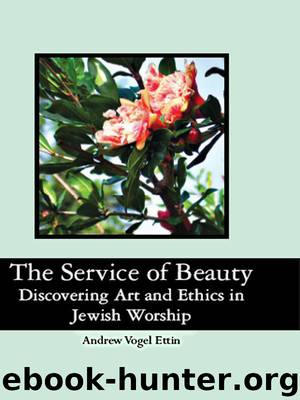The Service of Beauty: Discovering Art and Ethics in Jewish Worship by Andrew Vogel Ettin

Author:Andrew Vogel Ettin [Andrew Vogel Ettin]
Language: eng
Format: epub
Published: 2009-09-13T16:00:00+00:00
O chestnut-tree, great-rooted blossomer,
Are you the leaf, the blossom or the bole?
O body swayed to music, O brightening glance,
How can we know the dancer from the dance?
What is imparted to us at Sinai is a certain taxonomy for the tree of life, a particular choreography for the dance of living. The sweet savor, the full taste in the mouth, comes from the transformative conviction that it is possible and good to live in such wholeness.
This implies neither obligatory acceptance today of every word of the written Torah nor rejection of the very idea of religion as being expressed through law. The concept and actuality of the oral Torah implies that it must be a living document whose vitality depends on our daily actualizing of it. Nor would even the most radical antinomian want to live in a world without law.
At some places, during the Shavuot Torah reading the entire congregation stands for the recitation of the Ten Commandments. An effective way of doing this, where possible, is to gather the congregation at the foot of the bimah while members carefully hold up an open Torah scroll on the bimah facing the congregation; the reader chants the text that the congregation can actually see, dramatizing the idea that they witness the document that they are accepting. Others make this a time for a congregational retreat, journey to Israel, or a trip to a nearby mountain. That will not be Sinai but it can still move those who make the journey into another approach to the day’s spiritual potential.
If the absence of outstanding adaptations into other art forms is a measure of a work’s stature, the Book of Ruth, which is the designated special reading for Shavuot, is great. Economic as a work of art, this novella is continually open to discoveries of layers of meaning within it. The relationship between the maternal yet also sisterly Naomi and her widowed daughter-in-law Ruth, two women partnered in life by fate and choice, emerges with particular complexity through feminist analyses. A family fleeing from their country to a neighboring one to escape a famine, the personal disasters that ensue, Ruth’s treatment by Boaz and his harvesters as an resident alien farm-laborer—such themes compel us to comparisons with the stories in our newspapers and neighborhoods, and they touch our hearts and consciences as much as our minds. Ruth seems made for interpretation as drama, music, dance, bibliodrama or visual representation, but it rarely is. This work would call for a much more sophisticated treatment than the Purimspiel of Esther , subtler nuances than Handel needed for his oratorio on that narrative of a fictive Persia, with its big confrontations and emotions as well as clearly defined villains. There are no real villains in Ruth . It is a story in which the yetzer ha-ra , the impulse that causes distress, seems dormant. The 17th century French painter Nicolas Poussin caught the atmosphere effectively in his lovely pastoral harvest scene, “Summer: Ruth and Boaz,” where the
Download
This site does not store any files on its server. We only index and link to content provided by other sites. Please contact the content providers to delete copyright contents if any and email us, we'll remove relevant links or contents immediately.
| Haggadah | Hasidism |
| History | Holidays |
| Jewish Life | Kabbalah & Mysticism |
| Law | Movements |
| Prayerbooks | Sacred Writings |
| Sermons | Theology |
| Women & Judaism |
Man's Search for Meaning by Viktor E. Frankl(2252)
The Secret Power of Speaking God's Word by Joyce Meyer(2248)
Mckeown, Greg - Essentialism: The Disciplined Pursuit of Less by Mckeown Greg(2110)
MOSES THE EGYPTIAN by Jan Assmann(1968)
Unbound by Arlene Stein(1938)
Devil, The by Almond Philip C(1897)
The Complete Dead Sea Scrolls in English (7th Edition) (Penguin Classics) by Geza Vermes(1837)
I Capture the Castle by Dodie Smith(1567)
Schindler's Ark by Thomas Keneally(1508)
The Invisible Wall by Harry Bernstein(1458)
The Gnostic Gospel of St. Thomas by Tau Malachi(1408)
The Bible Doesn't Say That by Dr. Joel M. Hoffman(1371)
The Secret Doctrine of the Kabbalah by Leonora Leet(1265)
The Jewish State by Theodor Herzl(1251)
The Book of Separation by Tova Mirvis(1223)
A History of the Jews by Max I. Dimont(1205)
The Dead Sea Scrolls Bible by Martin G. Abegg(1197)
Political Theology by Carl Schmitt(1185)
Oy!: The Ultimate Book of Jewish Jokes by David Minkoff(1102)
